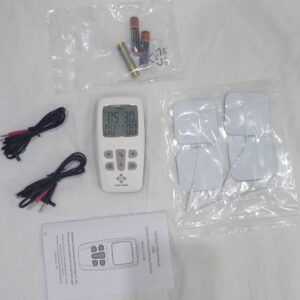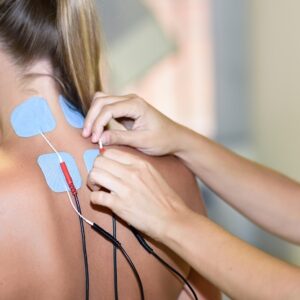EMS in Physiotherapy is a device that uses electrical impulses to empower muscle contractions. EMS is used for various purposes, including rehabilitation, muscle strengthening, pain management, and cosmetics. An electric muscle stimulation (EMS) unit is a device that delivers electrical impulses to the muscles through electrodes placed on the skin. The unit typically consists of a control module that generates electrical signals, wires or cables that connect the module to the electrodes and the electrodes themselves.
EMS units can vary in size and complexity, with some designed for use at home and others intended for use by healthcare professionals in clinical settings. Some branches are portable and battery-operated, while others require a power source. EMS in Physiotherapy units typically have adjustable settings for the electrical impulses’ frequency, intensity, and duration. These settings can be adjusted based on the individual’s needs and goals.
Read More: Read More about other Physiotherapy Modalities, TENS Therapy In Physiotherapy, What is Therapeutic Laser Therapy?, and Therapeutic Ultrasonography.
Table of Contents
Indications of Ems
EMS in Physiotherapy is a non-invasive treatment that uses electrical impulses to stimulate muscles.
1. Muscle strengthening: EMS can strengthen muscles and improve overall performance. Athletes or fitness enthusiasts often use it as a supplement to their training regimen.
2. Rehabilitation: EMS can be part of a rehabilitation program for individuals with muscle injuries or weakness. It can help to improve muscle strength, range of motion, and overall function.
3. Pain relief: EMS can provide pain relief for individuals with certain types of pain, such as muscle or back pain. It may work by reducing muscle tension and increasing blood flow to the affected area.
4. Improved circulation: EMS can be used to improve blood flow to muscles, which can help to reduce muscle fatigue and soreness.
5. Relaxation: EMS can promote relaxation and reduce stress. It may work by stimulating the release of endorphins, natural painkillers and mood boosters.
It’s important to note that EMS in Physiotherapy may not be appropriate for everyone and should be used under the guidance of a healthcare professional or certified EMS trainer. Consult an accredited therapist or EMS that suits your specific needs and goals.
Mechanism of EMS in Physiotherapy
The EMS mechanism involves using electrical impulses to stimulate muscle contractions. When the EMS device delivers a controlled electrical current to the muscles through the electrodes, it causes the muscle fibres to contract and relax. The electrical impulses’ frequency, intensity, and duration can be adjusted to target specific muscles and achieve desired results.
The electrical impulses trigger the release of calcium ions in the muscle cells, which leads to the contraction of the muscle fibres. This contraction is similar to the contraction during voluntary muscle movements, such as lifting or walking. However, the electrical stimulation from EMS can cause more intense and frequent muscle contractions than voluntary muscle movement.
Over time, repeated muscle contractions from EMS in Physiotherapy can improve muscle strength and tone. This is because the muscle fibres adapt to the increased demand of the electrical stimulation, leading to hypertrophy (increased muscle size) and improved neuromuscular coordination.
In addition to its effects on muscle strength and tone, EMS has also been shown to increase blood flow to the muscles, aiding healing and recovery. It may also help to reduce pain and inflammation by stimulating the release of endorphins, the body’s natural painkillers. Overall, the mechanism of EMS involves the use of electrical impulses to activate muscle contractions and promote improvements in muscle strength, tone, and function
Currents in EMS
EMS (Electrical Muscle Stimulation) machines use electrical current to stimulate muscles. The type of current used in EMS is typically a
- Low-frequency,
- Medium-voltage,
- Biphasic waveform.
This type of current is often called a “Russian current” or “Russian stimulation” and is characterized by a series of rapid, alternating pulses of electrical current. They can also go in the electrical current type, with some using a low-frequency alternating current (AC) and others using a medium-frequency direct current (DC).
The electrical current used in EMS machines is delivered through electrodes placed on the skin over the targeted muscles. The electrical impulses cause the muscles to contract and relax, which can help to increase strength, endurance, and overall muscle performance. It’s important to note that different EMS machines may use different types of electrical currents or waveforms, and the specific type of current used can affect the effectiveness and safety of the treatment. Always consult a certified therapist EMS trainer for guidance on the appropriate kind of EMS machine and electrical current for your specific needs.
An EMS Machine

An EMS machine typically consists of a control unit and electrodes. The control unit contains the power source, circuitry, and controls for adjusting the electrical impulses’ frequency, intensity, and duration. The electrodes are placed on the skin over the targeted muscles and are connected to the control unit by wires.
EMS machines can vary in size and design, with some being portable and handheld while others are larger and meant to be used in clinical settings.
Some EMS machines also include pre-programmed settings for different muscle groups and treatment goals, while others allow for more customization of the electrical impulses. It’s essential to follow the instructions provided with the EMS machine and to work with a healthcare professional to ensure proper use and effectiveness.
When using an EMS machine, the electrodes are placed on the skin area over the targeted muscles, and the device is turned on to deliver electrical impulses to the muscles. The user may feel a tingling or pulsing as the muscles contract and relax. The electrical impulses’ frequency, intensity, and duration can be adjusted to achieve the desired results. Regular use of an EMS machine, along with proper nutrition and exercise, can help promote improvements in muscle strength, tone, and function.
How to Use EMS–Electrodes Placement

The placement of EMS electrodes depends on the targeted muscles and the specific goals of the treatment. Here are some general guidelines for electrode placement:
1. Identify the targeted muscles: Determine which muscles you want to target with the EMS treatment.
2. Clean the skin: Before applying the electrodes, clean the skin with soap and water or an alcohol wipe to remove any oils or dirt that could interfere with the electrical current.
3. Place the electrodes: Attach the electrodes to the skin over the targeted muscles. The number and placement of the electrodes will depend on the type of EMS machine and the targeted muscles. In general, electrodes should be placed on both sides of the muscle group, with the positive electrode (also called the anode) placed over the belly of the muscle and the negative electrode (also called the cathode) placed over the tendon or origin of the muscle.
4. Adjust settings: Turn on the EMS machine and adjust the settings for the electrical impulses’ frequency, intensity, and duration. Start with low settings and gradually increase as tolerated. Start treatment: Once the settings are adjusted, start the treatment. The user may feel a tingling or pulsing as the muscles contract and relax. Staying relaxed and avoiding tensing the muscles during the treatment is essential.
Literature Review-EMS in Physiotherapy
Recent research supports the use of Electric Muscle Stimulation EMS in Physiotherapy for various purposes, including muscle strengthening, rehabilitation, and pain relief. Here are some examples:
Muscle strengthening: A systematic review and meta-analysis research paper published (2019) found that EMS can effectively improve muscle strength in healthy individuals and athletes.
Rehabilitation: A randomized controlled trial research paper
published in the (2019) found that EMS can be an effective adjunct to physical therapy for improving muscle function and mobility in patients with stroke.
Pain relief:
A systematic review and meta-analysis research paper (2018) found that EMS can effectively minimize pain in the MSK problems.
Exercise performance: A randomized controlled trial published in the Journal of Sports Science and Medicine (2019) found that EMS can improve muscle activation and exercise performance in elite rugby players.
Overall, the literature suggests that EMS can be useful for various applications, including muscle strengthening, rehabilitation, pain relief, and exercise performance.
Contraindications of EMS
While EMS in Physiotherapy is generally considered safe when used properly, certain situations may be contraindicated or not recommended. Some of the contraindications of EMS include the following:
1. Pregnancy: EMS should not be used during pregnancy, as the effects on fetal development are unknown.
2. Pacemakers and other implanted medical devices: EMS in Physiotherapy should not be used on individuals with pacemakers or other devices, as the electrical impulses may interfere with the device’s function.
3. Epilepsy or seizures: EMS may trigger attacks in individuals with epilepsy or a history of seizures.
4. Active cancer: EMS should not be used on areas of the body with active cancer or individuals with a history of cancer, as the electrical impulses may stimulate tumors growth.
5. Skin irritation or open wounds: EMS should not be used on areas of the body with skin irritation or open wounds, as it may cause further irritation or delay healing.
6. Acute inflammation or infection: EMS should not be used on areas of the body with acute inflammation or infection, as it may worsen the condition.
It’s essential to consult with a healthcare professional before using EMS in Physiotherapy, especially if you have any underlying medical conditions or concerns. They can help determine whether EMS in Physiotherapy is safe and appropriate for your needs and goals.
Summary
Electric muscle stimulation (EMS) is a therapeutic technique that uses electrical impulses to stimulate muscles.
During EMS, electrodes are placed on the skin over the targeted muscles. These electrodes deliver electrical impulses to the muscles, causing them to contract and relax.
EMS in Physiotherapy helps individuals who have suffered injuries or illnesses that have resulted in muscle weakness or atrophy. By stimulating the muscles, EMS in Physiotherapy can help improve muscle strength and function.
EMS can also be used as a form of exercise, with some individuals using it to complement their regular workout routine. However, it is essential to note that EMS use must be under the supervision of trained professionals, as improper use can cause injury. EMS in Physiotherapy can be a helpful tool for individuals looking to improve muscle strength and function and those undergoing rehabilitation after an injury or illness.

One Response